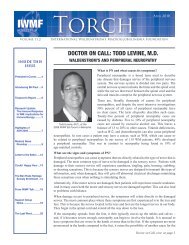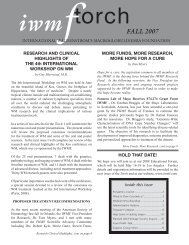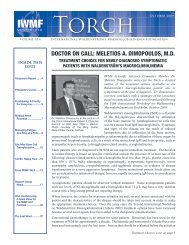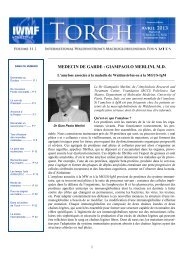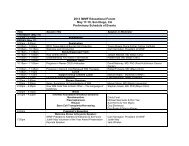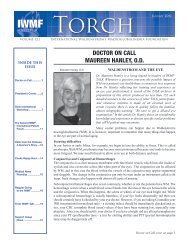English - International Waldenstrom's Macroglobulinemia Foundation
English - International Waldenstrom's Macroglobulinemia Foundation
English - International Waldenstrom's Macroglobulinemia Foundation
Create successful ePaper yourself
Turn your PDF publications into a flip-book with our unique Google optimized e-Paper software.
ASH Highlights, cont. from page 13<br />
IgM-MGUS and WM and could help identify IgM-MGUS<br />
patients who are at high risk for progression to WM.<br />
Another Italian study performed extensive flow cytometry<br />
(cell surface marker) analysis for identification of the<br />
WM clone in IgM-MGUS and WM. Bruno Paiva, et al.<br />
analyzed bone marrow samples from 244 patients, including<br />
67 IgM-MGUS, 77 smoldering, and 100 symptomatic<br />
newly diagnosed WM patients. The study first analyzed<br />
the percentage of B-cells and plasma cells and then the<br />
percentage of light chain restricted cells in both sets of cells.<br />
Light chain restriction can identify the presence of clonal<br />
cells by determining if they are all either kappa or lambda<br />
type. The results showed a progressive increase in B-cells<br />
from IgM-MGUS to smoldering to symptomatic WM (2%,<br />
9%, and 12%, respectively), as well as an increase in light<br />
chain restricted B-cells (75%, 96%, and 99%, respectively).<br />
In contrast, the percentage of plasma cells did not increase<br />
from IgM-MGUS to smoldering to symptomatic WM, but the<br />
percentage of light chain restricted plasma cells did (70%,<br />
85%, and 97%, respectively). The study determined that<br />
an increased number of B-cells and light chain restricted<br />
B-cells, but not plasma cells, tended to predict an increased<br />
risk of progression from smoldering to symptomatic WM and<br />
inferior overall survival in symptomatic WM. There was also<br />
a progressive increase in CD22, CD25, and sIgM markers in<br />
B-cells from IgM-MGUS to smoldering to symptomatic WM.<br />
A bimodal expression of the B-cell memory marker CD27<br />
(from negative to positive) was found in more than 50% of<br />
WM patients, raising the possibility that the WM clone may<br />
arise, at least in some cases, before antigenic stimulation;<br />
subsequent development of the clone into plasma cells would<br />
explain the presence of somatic hypermutations (the process<br />
whereby B-cells acquire additional mutations to better target<br />
antigens). B-cells from IgM-MGUS and WM patients were<br />
negative in 90% of cases for surface markers CD5, CD10,<br />
CD11c, and CD103, which can be useful for differentiating<br />
between WM and other B-cell non-Hodgkin’s lymphomas.<br />
Within the plasma cell compartment, there was a progressive<br />
increase of light chain restricted clonal plasma cells<br />
displaying an immature appearance, as patients progressed<br />
from IgM-MGUS to smoldering to symptomatic WM.<br />
Stephanie Poulain, et al. from France discussed the evolution<br />
of the WM clone during the course of disease. Current<br />
models of cancer progression suggest that cancer cells<br />
acquire additional genetic lesions over time because they<br />
are inherently genetically unstable. This particular analysis<br />
looked at changes in clonal WM bone marrow cells of 19<br />
untreated individuals compared to paired normal cells in the<br />
same patients. At initial sampling, the analysis detected a<br />
total of 76 alterations in the normal number of gene copies,<br />
including 22 gains and 54 losses; 85% of patients had the<br />
MYD88 L265P mutation. During follow-up of WM patients<br />
who remained indolent, no new genetic abnormalities have<br />
been observed. Among the 11 remaining patients, genetic<br />
changes were observed in 6 cases. The early data support<br />
the hypothesis that symptomatic disease favors genetic clonal<br />
evolution of tumor cells.<br />
FAMILIAL WM<br />
A joint Duke University-National Cancer Institute study,<br />
reported by Dr. Mark C. Lanasa, et al. examined the<br />
prevalence of circulating malignant B-cells in IgM-MGUS<br />
and WM/LPL by using flow cytometry (cell surface marker<br />
detection). This work is based on previous studies which<br />
showed that clonal populations of chronic lymphocytic<br />
leukemia (CLL)-like circulating B-cells can be identified<br />
in 18% of family members of CLL patients. Because CLL<br />
and WM/LPL have related gene expression profiles and<br />
shared genetic risk, this study hypothesized that unaffected<br />
family members of WM/LPL families would also have<br />
detectable circulating clonal B-cell populations. A total of<br />
155 individuals were analyzed. Twenty of 41 WM/LPL<br />
patients (49%) had peripherally circulating B-cell clones<br />
detected. Interestingly, peripherally circulating B-cell<br />
clones were detected in 9 of 17 cases (53%) of IgM-MGUS,<br />
a proportion nearly identical to that identified in WM/LPL.<br />
Among unaffected family members, however, the study<br />
identified circulating B-cell clones in only 4 of 81 (5%), and<br />
these more closely resembled CLL-like clones. Unlike the<br />
CLL-like clones, most of the clones identified in WM/LPL<br />
patients have an otherwise normal B-cell phenotype and can<br />
only be detected by the presence of light chain restriction –<br />
that is, the cells all have one type of light chain, either kappa<br />
or lambda, indicating clonality. This likely limits the ability<br />
of flow cytometry to detect low levels of WM/LPL clonal<br />
cells in the bloodstream.<br />
PRE-CLINICAL DRUGS<br />
Dr. Isere Kuiatse, et al. discussed pre-clinical results in a<br />
multi-center study of a spleen tyrosine kinase (SYK) inhibitor<br />
called fostamatinib in cell lines and animal models of WM.<br />
SYK is over-expressed in WM cells, and a recent Phase I/<br />
II trial of fostamatinib in patients with a variety of non-<br />
Hodgkin’s lymphomas showed evidence of activity in three<br />
patients with WM. In this multi-center study, fostamatinib<br />
reduced the viability of WM cell lines and delayed tumor<br />
growth in mice which were injected with cells from a WM<br />
cell line.<br />
Ublituximab is a novel chimeric (part mouse/part human) anti-<br />
CD20 monoclonal antibody that has been engineered with a<br />
high affinity for the FcyRIIIa receptor, which is involved in<br />
the success of response to rituximab therapy. A French study,<br />
reported by Magali Le Garff-Tavernier of Pitié Salpêtrière,<br />
evaluated this new antibody’s ability to activate natural killer<br />
cells and compared it to rituximab. Natural killer cells are an<br />
important part of the body’s immune system that target B-cells<br />
attached to rituximab (and other anti-CD20 antibodies) and<br />
kill them. Blood samples from 37 untreated WM patients and<br />
ASH Highlights, cont. on page 15<br />
14 IWMF TORCH Volume 14.2





